
Protein arginine methyltransferase 5 (PRMT5) is a critical regulatory protein linked to genome organization, cell cycle regulation, and stem cell differentiation1. It forms an active complex with MEP50 and transfers methyl groups from S-adenosylmethoinine (SAM) to histone proteins, transcription factors, and other regulatory proteins. These methylations form mono and symmetrically di-methylated arginine residues. Dysregulation of PRMT5 activity is associated with many cancers including lymphomas, lung cancer, and breast cancer. Additionally, PRMT5 is linked to kidney disease, heart disease, and neurological disorders including Huntington’s and Alzheimer’s.
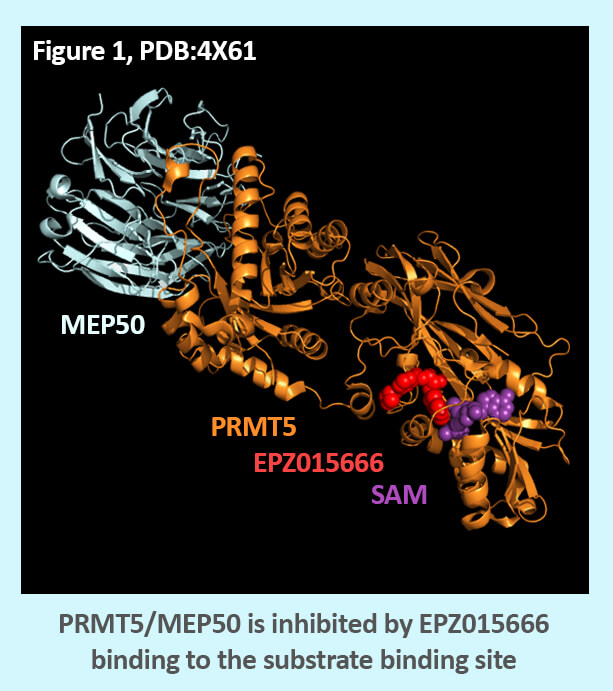
Recent scientific breakthroughs have caused PRMT5 to emerge as a promising new drug target. New findings in both the specific inhibition of PRMT5 and in metabolic pathways linked to its activity have brought new attention to this important protein.
As with all enzymatic targets, a major challenge is to find inhibitory compounds that do not significantly inhibit closely related proteins. Simple SAM-analogs can serve as general methyltransferase inhibitors but are not particularly specific. A breakthrough in PRMT5 inhibition came in the development of the chemical probe EPZ0156662. EPZ015666 is a nM inhibitor of PRMT5 activity through competitive inhibition for peptide substrates (Figure 1). Furthermore, it is selective and shows no inhibition against a panel of other PRMTs up to mM concentrations.
Beyond direct inhibition of interaction with protein substrates, interesting strategies for fighting cancer through targeting PRMT5 come from recent discoveries about related metabolic pathways. Methylthioadenosine phosphorylase (MTAP) catalyzes the phosphorylation of methyl-thioadenosine (MTA) as part of the methionine salvage pathway3.
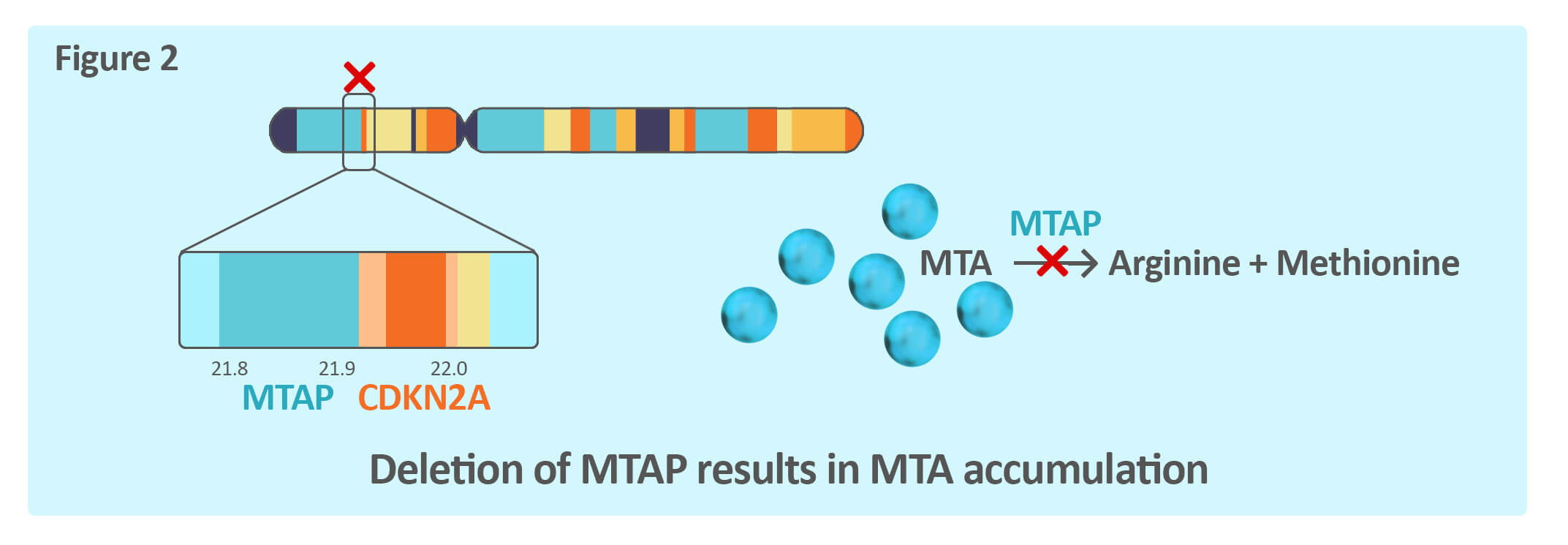
The gene encoding MTAP is closely associated with the tumor suppressor gene CDKN2A (Figure 2). These genes are located at the chr9p21 locus and are common heterozygous deletions in many forms of cancer. Recent studies of the role of MTAP in cancer have focused on shRNA screens to identify genes of particular importance to the proliferation of MTAP deficient cells4-6. Common to these studies are the observations that MTAP cells show significantly enhanced dependency on PRMT5 and methionine adenosyltransferase II alpha (MAT2A), a SAM biosynthesis pathway enzyme.
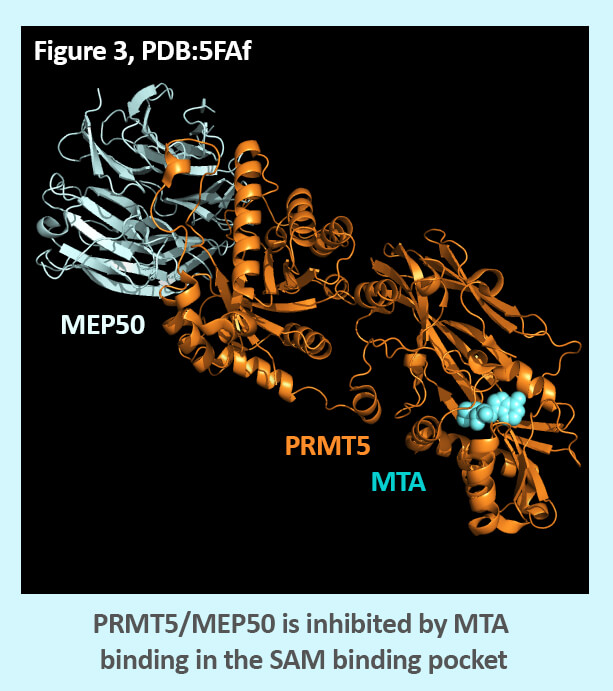
Illustrated in Figure 2, MTA accumulates in MTAP cells. Through both biochemical and structural studies, MTA has been shown to be a competitive inhibitor for the SAM binding site of PRMT5 (Figure 3)4-6. MTA is also selective for PRMT5.
These studies suggest that PRMT5 dependence of MTAP cells results from partial inhibition of PRMT5 activity through increased cellular levels of MTA (Figure 4). This opens the possibility for developing PRMT5 inhibitors that either target SAM binding or that stabilize MTA:PMRT5 complexes in MTAP cancers.
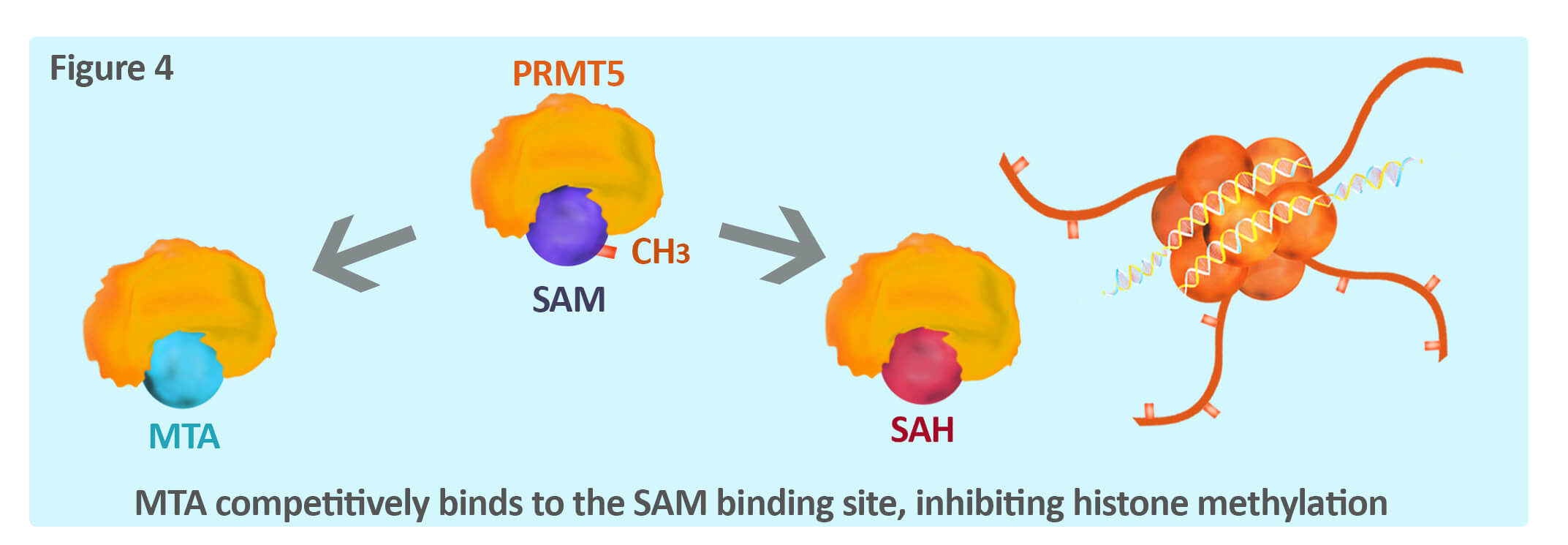
The role of MAT2A in SAM biosynthesis and its connection to the proliferation of MTAP- cells also provides an opportunity for PRMT5 based cancer treatments5. Loss of MAT2A has been shown to reduce cellular SAM levels and contribute to a loss of PRMT5 activity in MTAP cells (Figure 5). This suggest the intriguing possibility of targeting MAT2A to decrease SAM levels and tip the balance favoring MTA inhibition of PMRT5 in MTAP cells.
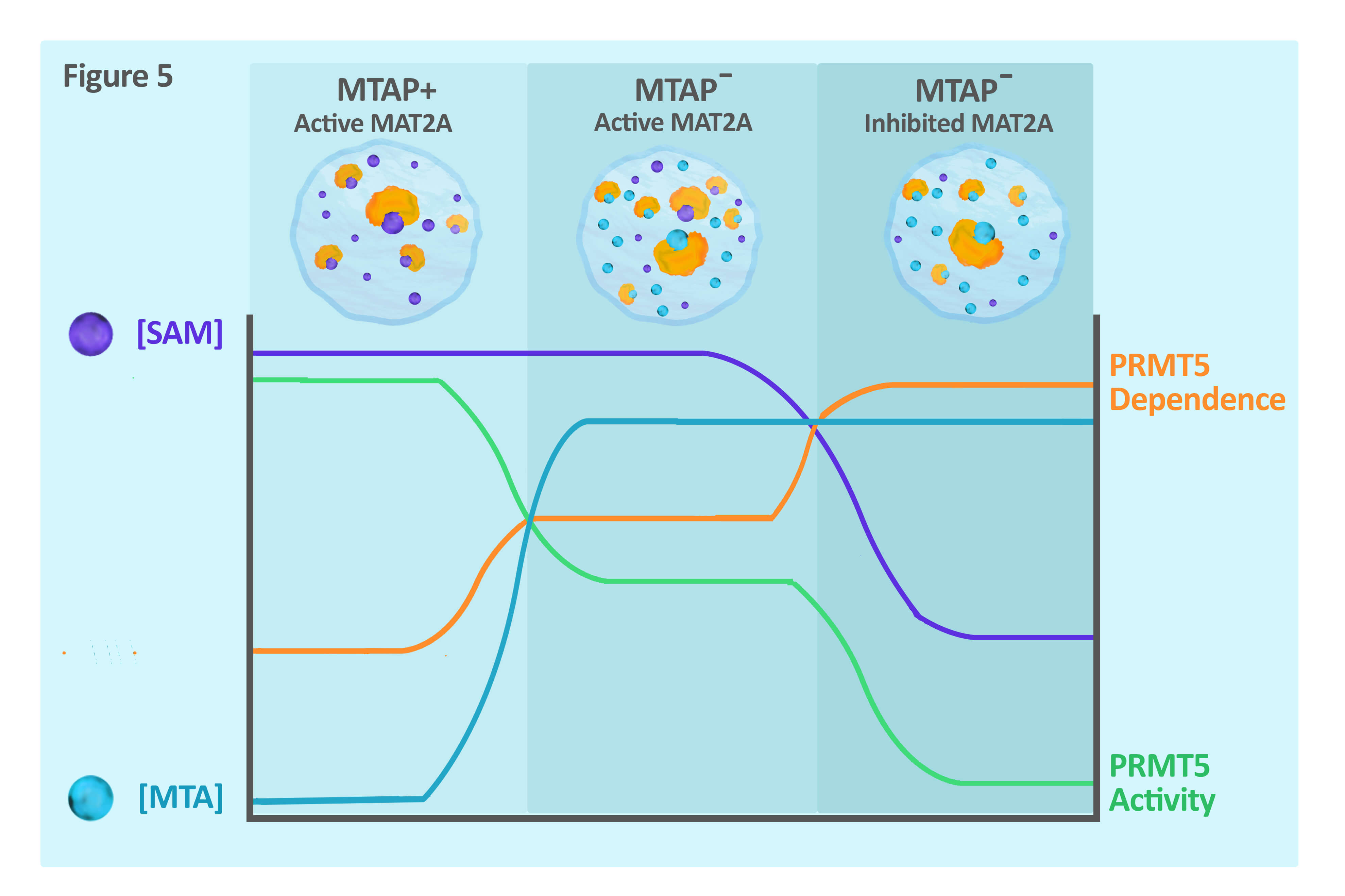
For a more complete and detail product listing, click below:
| USBio Catalog # | Product Name |
|---|---|
| 137298 | Histone H4, Peptide Substrate, Di-methylated R3 (Biotin) |
| 137363 | PRMT4, Peptide Substrate (CARM1, Histone-arginine Methyltransferase CARM1, Coactivator-associated Arginine Methyltransferase 1, Protein Arginine N-methyltransferase 4) (Biotin) |
| 298449 | PRMT1, Chemiluminescent, BioAssay™ Kit (Protein Arginine Methyltransferase 1, HRMT1L2, IR1B4, HCP1) |
| 298450 | PRMT3, Chemiluminescent, BioAssay™ Kit (Protein Arginine Methyltransferase 3, HRMT1L3) |
| 298451 | PRMT4, Chemiluminescent, BioAssay™ Kit (CARM1, Coactivator-Associated Arginine Methyltransferase 1) |
| 298452 | PRMT5, Chemiluminescent, BioAssay™ Kit (Protein Arginine Methyltransferase 5, HRMT1L5, IBP72, JBP1, SKB1) |
| 298453 | PRMT6, Chemiluminescent, BioAssay™ Kit (Protein Arginine N-Methyltransferase 6, Histone-Arginine N-Methyltransferase, HRMT1L6) |
| 376995 | HMT Assay Buffer 2 (4X) |
| 376996 | HMT Assay Buffer 2A (4X) |
| 376997 | HMT Assay Buffer 5 (4X) |
[1] Stopa, N., Krebs, J. E., and Shechter, D. (2015) The PRMT5 arginine methyltransferase: many roles in development, cancer and beyond, Cellular and Molecular Life Sciences : CMLS 72, 2041-2059.
[2] Chan-Penebre, E., Kuplast, K. G., Majer, C. R., Boriack-Sjodin, P. A., Wigle, T. J., Johnston, L. D., Rioux, N., Munchhof, M. J., Jin, L., Jacques, S. L., West, K. A., Lingaraj, T., Stickland, K., Ribich, S. A., Raimondi, A., Scott, M. P., Waters, N. J., Pollock, R. M., Smith, J. J., Barbash, O., Pappalardi, M., Ho, T. F., Nurse, K., Oza, K. P., Gallagher, K. T., Kruger, R., Moyer, M. P., Copeland, R. A., Chesworth, R., and Duncan, K. W. (2015) A selective inhibitor of PRMT5 with in vivo and in vitro potency in MCL models, Nature Chemical Biology 11, 432-437.
[3] Bertino, J. R., Waud, W. R., Parker, W. B., and Lubin, M. (2011) Targeting tumors that lack methylthioadenosine phosphorylase (MTAP) activity: current strategies, Cancer Biology & Therapy 11, 627-632.
[4] Kryukov, G. V., Wilson, F. H., Ruth, J. R., Paulk, J., Tsherniak, A., Marlow, S. E., Vazquez, F., Weir, B. A., Fitzgerald, M. E., Tanaka, M., Bielski, C. M., Scott, J. M., Dennis, C., Cowley, G. S., Boehm, J. S., Root, D. E., Golub, T. R., Clish, C. B., Bradner, J. E., Hahn, W. C., and Garraway, L. A. (2016) MTAP deletion confers enhanced dependency on the PRMT5 arginine methyltransferase in cancer cells, Science (New York, N.Y.) 351, 1214-1218.
[5] Marjon, K., Cameron, M. J., Quang, P., Clasquin, M. F., Mandley, E., Kunii, K., McVay, M., Choe, S., Kernytsky, A., Gross, S., Konteatis, Z., Murtie, J., Blake, M. L., Travins, J., Dorsch, M., Biller, S. A., and Marks, K. M. (2016) MTAP Deletions in Cancer Create Vulnerability to Targeting of the MAT2A/PRMT5/RIOK1 Axis, Cell Reports 15, 574-587.
[6] Mavrakis, K. J., McDonald, E. R., 3rd, Schlabach, M. R., Billy, E., Hoffman, G. R., deWeck, A., Ruddy, D. A., Venkatesan, K., Yu, J., McAllister, G., Stump, M., deBeaumont, R., Ho, S., Yue, Y., Liu, Y., Yan-Neale, Y., Yang, G., Lin, F., Yin, H., Gao, H., Kipp, D. R., Zhao, S., McNamara, J. T., Sprague, E. R., Zheng, B., Lin, Y., Cho, Y. S., Gu, J., Crawford, K., Ciccone, D., Vitari, A. C., Lai, A., Capka, V., Hurov, K., Porter, J. A., Tallarico, J., Mickanin, C., Lees, E., Pagliarini, R., Keen, N., Schmelzle, T., Hofmann, F., Stegmeier, F., and Sellers, W. R. (2016) Disordered methionine metabolism in MTAP/CDKN2A-deleted cancers leads to dependence on PRMT5, Science (New York, N.Y.) 351, 1208-1213.